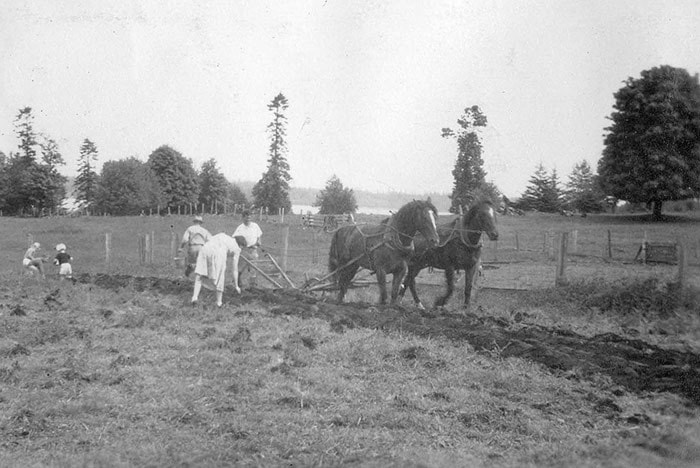Beth Boyce
Curator, Museum at Campbell River
There were three main industries that shaped the lives of the people who settled north of the Campbell River in the early years of that community: logging, fishing and farming.
The families that settled there may have started working in other industries, but they all ended up clearing large tracts of land to raise cattle, pigs, sheep, and chickens, and to grow wheat, fruit and vegetables. The Vanstones, Perkins, Pooles, Merediths, and Hudsons were all close neighbours who helped each other manage their farms and they even shared their supplies. Everyone helped with haying and when one family went away for a day or two, members of the other families would pitch in to ensure the animals were well looked after.
It was a close-knit community.
Winter sports such as skiing on Vanstone’s hill, and skating on the flooded frozen north field at Hudson’s farm were recreations that were well loved and are well remembered by area residents who grew up there. Also well remembered were days of freely playing on the beaches and in the river in the summer months before the dam was built. At Christmas time Grandpa Perkins would dress up as Santa Clause and visit all the children of the Vanstone and Perkins clans in their homes. Of course, it helped that they left out beer and cookies for Santa at every stop!
The other major player in the early North Campbell River community was the famous Painter’s Lodge. The sons of the Vanstones and Perkins worked as fishing guides, and the wives and daughters could often be found working at the lLodge or in its kitchen.
Pat Hodgkinson (née Perkins) remembers that her mother used to work in the kitchen at Painter’s Lodge. She said that her chores at home often involved cleaning up after her mother in the kitchen, as she was not the tidiest cook. Later, when Pat went to work at Painter’s Lodge, she was assigned the task of cleaning up after her mother in the lodge’s kitchen, a task for which she was already fully trained!
The lodge had a small dairy farm and garden operation to keep the kitchen well stocked and also bought milk from Hudson’s when their supplies ran low. Painter’s Lodge was built on land purchased from Tom Hudson, and the Painter and Hudson families have had a close relationship for decades, playing together as children and sharing Christmases up to the present year.
Changes affected all of Campbell River when the John Hart Dam and later the Elk Falls Mill were constructed and operating, but the changes were felt especially strongly in North Campbell River. New families began moving to the area, roads were paved, and the traffic on the highway steadily increased.
As employment in the area shifted to construction and the mill, the farms were slowly set aside, parcelled off, and residential neighbourhoods grew up in their place. Today only one farm remains in North Campbell River, and remarkably, it is still being farmed by the descendants of Tom and Mavis Hudson.
The Museum at Campbell River has been working in partnership with Shaw TV with funding through the New Horizons for Seniors Program from the Government of Canada to produce a documentary recording the memories of long time residents of North Campbell River, to capture the history of the community and some of the changes that took place as Campbell River boomed and developed. Look for its release in April.

